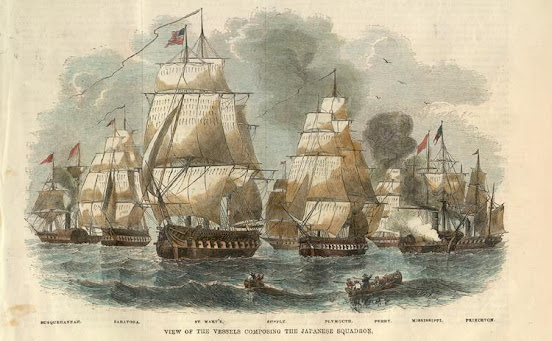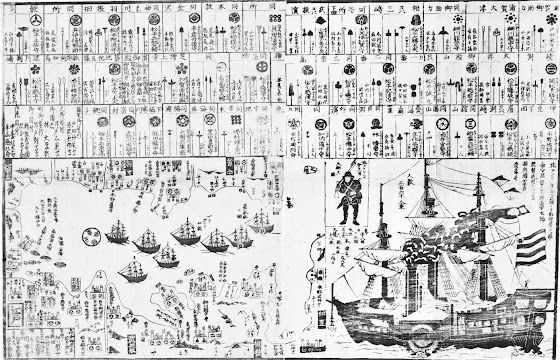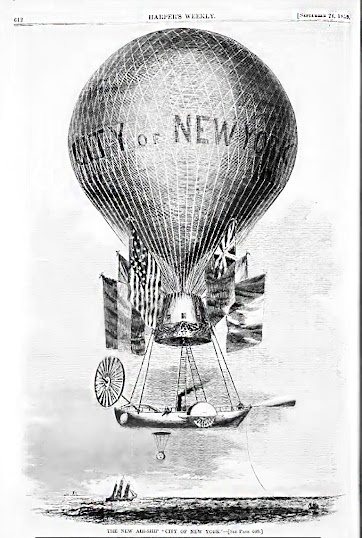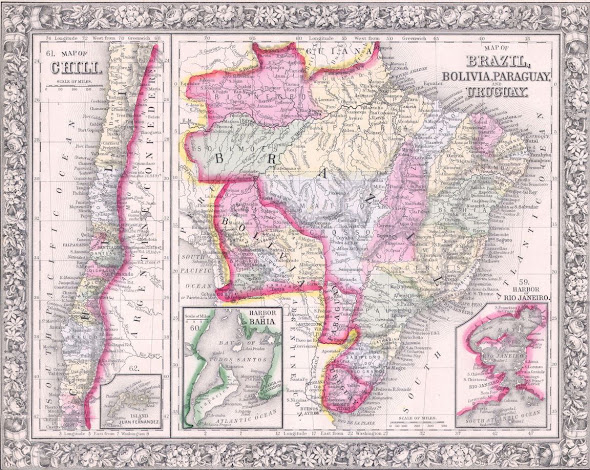Commodore Perry Returns
Perry now turned his attention to the small
islands between Japan and China. At the time, several of these were small
kingdoms. At each, Perry exacted a treaty similar to the one he would
negotiate with Japan. The treaties provided sailors washed ashore would be well
treated; that the king would sell supplies to American ships, in return
Americans would buy from nobody else on the islands; and, that the kingdoms
would serve as coal storage points for the American navy. This last part
encountered opposition. The islanders had no wish to be responsible for
coal that might be washed/blown away in a typhoon, pilfered by the natives, seized
by pirates or other navies, etc., and then suffer the threatened consequences by
the US Navy.
A Russian fleet had reached Japan only a few weeks
after Perry in 1853. The Russians left
hurriedly without a treaty on hearing the Crimean War had started and guessed
the French and British Far East Fleets would soon come chasing them.
In early 1854, Perry received word the French and
British were preparing to send delegations to Japan to negotiate treaties. Now,
in charge of a fleet of eight ships, Perry decided he would beat them to it and
return before July 1854. He had given
the Japanese government a year because he knew the shogun would need a
long time to summon daimyos (noblemen who each governed a province) and
to adjust to coming out of isolation.
Perry stopped at Formosa, now Taiwan, and found it occupied by indigenous headhunters and descendants of Chinese farmers. He urged the US to annex the island as it would be useful in the future as a repair and coal station.
On February 11, 1854, Perry’s ships arrived in Yokohama
harbor, a move calculated, Perry later wrote, to demonstrate he did not bow to
the power of the Japanese nobility.
Foreigners were always directed to Nagasaki as Perry was when he entered
Uraga Bay near Yokohama harbor in July 1853. Yokohama was
close to Edo, the capital, and home of the shogun and emperor.
USS Susquehanna in NY Harbor
To emphasize his power, Perry would only directly deal with
the shogun’s or emperor’s highest representatives, leaving his officers
to deal with any lesser noble bearing messages. By the beginning of March, the Commodore had
grown weary and angry with Japanese delay in starting negotiations. Perry made
a flat out threat to summon a hundred ships in the next twenty days to bombard
and lay waste the city and palace. There
were not a hundred ships in the entire US Navy but the Japanese did not know
that. Negotiations started March 8, 1854. By March 31, 1854, “The Treaty of
Peace and Amity” was signed.
A color print of Perry landing
The Americans agreed to use only the
ports of Shimoda and Hakodate; and a consulate in Shimoda
Sailors would be treated well and
foreigners would be allowed to live and travel in Japan
The Japanese government was to have a
monopoly selling supplies to American ships.
A currency rate of exchange was to be
set up facilitating trade between the two countries
Mutual peace between America and
Japan
If Japan concluded a more favorable
treaty with another foreign power, the US was to receive the same extra
benefits
(now called a “most favored nation”
clause)
Given the distances, a year and a half was allowed for the
treaty to be ratified.
Perry never returned to Japan after the treaty was
signed. Congress voted him a $20,000 grant
for his services, commissioned him to write a full report of his service in the
Far East, and promoted him to rear admiral on the retired list. Perry devoted himself to what became three volumes
of Narrative of the Expedition of an American Squadron in the China Seas and
Japan finished at the end of 1857. Gout and years of very heavy drinking
caught up with him and he died in New York City on March 4, 1858, survived by his
wife and nine of their ten children.
While remembered today for the trip to Japan, Matthew Perry’s
career was studded with outstanding military achievements. His father had been a captain in the American
Navy in the late 1700s. His older
brothers, including Oliver Hazard Perry, a hero of the War of 1812, were all
captains. Matthew Perry began his career in 1809
and liked to say while his brother was a hero of the War of 1812, Matthew had
fired the first shot. An enthusiastic backer of modern technology and instruction,
he supervised the construction of the first steam powered American warship, USS
Mississippi, and was its first captain.
He helped modernize the curriculum for cadets at Annapolis. In the Mexican American War, he saw combat personally
leading 1,700 men in the successful assault on San Juan Bautista. In the interim
he fought pirates in the Mediterranean and served in the squadron interdicting slave
ships off the west coast of Africa.
Obit of Perry in Harper's Weekly March 1858
British set out in 1854 for Japan












Comments
Post a Comment